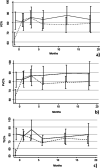A mini-whole lung lavage to treat autoimmune pulmonary alveolar proteinosis (PAP)
- PMID: 35300687
- PMCID: PMC8932062
- DOI: 10.1186/s12931-022-01982-2
A mini-whole lung lavage to treat autoimmune pulmonary alveolar proteinosis (PAP)
Abstract
Background: PAP is an ultra-rare respiratory syndrome characterized by the accumulation of surfactant within the alveoli. Whole lung lavage (WLL) is the current standard of care of PAP, however it is not a standardized procedure and the total amount of fluid used to wash each lung is still debated. Considering ICU hospitalization associated risks, a "mini-WLL" with anticipated manual clapping and reduced total infusion volume and has been proposed in our center. The aim of the study is to retrospectively analyze the efficacy of mini-WLL compared to standard WLL at the Pavia center.
Methods: 13 autoimmune PAP patients eligible for WLL were included: 7 patients were admitted to mini-WLL (9 L total infusion volume for each lung) and 6 patients underwent standard WLL (14 L of infusion volume). Functional data (VC%, FVC%, TLC%, DLCO%) and alveolar-arterial gradient values (A-aO2) were collected at the baseline and 1, 3, 6, 12, 18 months after the procedure.
Results: A statistically significant improvement of VC% (p = 0.013, 95%CI 3.49-30.19), FVC% (p = 0.016, 95%CI 3.37-32.09), TLC% (p = 0.001, 95%CI 7.38-30.34) was observed in the mini-WLL group in comparison with the standard WLL group, while no significant difference in DLCO% and A-aO2 mean values were reported.
Conclusion: Mini-WLL has demonstrated higher efficacy in ameliorating lung volumes, suggesting that a lower infusion volume is sufficient to remove the surfactant accumulation and possibly allows a reduced mechanical insult of the bronchi walls and the alveoli. However, no statistically significant differences were found in terms of DLCO% and Aa-O2.
Keywords: ICU stay; Pulmonary alveolar proteinosis; Whole lung lavage.
© 2022. The Author(s).
Conflict of interest statement
The authors declare no competing interests.
Figures
References
MeSH terms
Substances
Supplementary concepts
LinkOut - more resources
Full Text Sources
Medical
Research Materials


